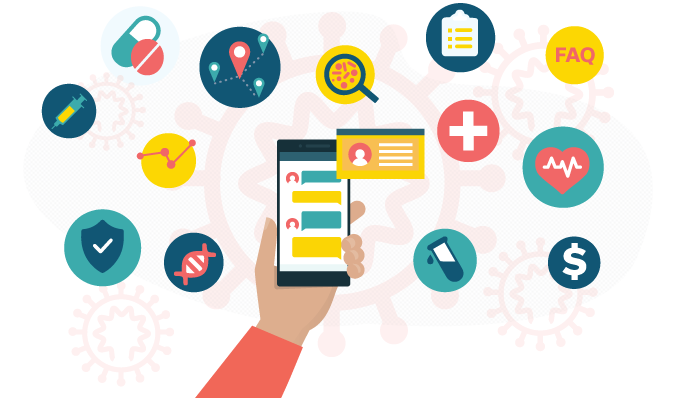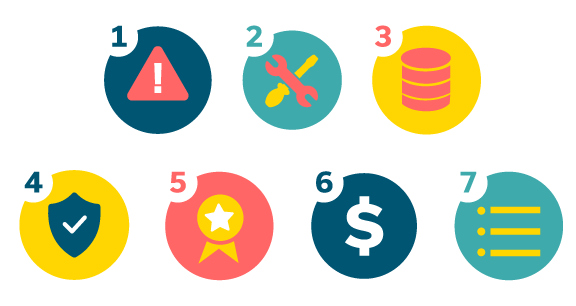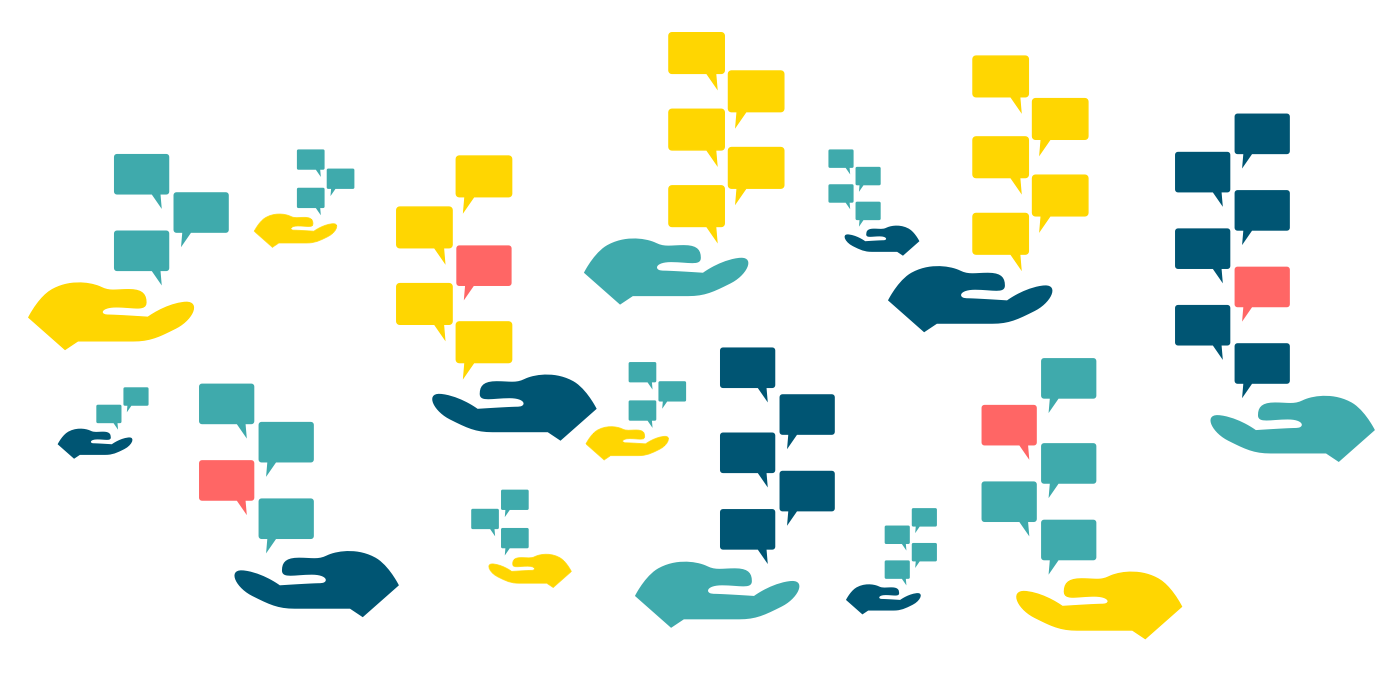In just over a month, the perception of conversational chatbot technology for healthcare shifted from “this has interesting potential” to “what else can this do for us?” Beginning in March 2020, we saw an explosion of mobile chatbot solutions hit the market to help screen millions of potential COVID-19 patients in the emergency room front lines.
Digital agent bots helped hospitals manage the surge in patient demand by screening patients for symptoms and history through mobile devices or PCs. And they provided this vital service remotely, with unlimited conversational capacity. Nobody had to wait on hold for 2 hours to find out what to do because they had a fever or sore throat.
Today COVID-19 chatbots are still in place, handling inquiries and providing answers. Millions of patients, most who have never even heard of a chatbot before, have used the technology as a first-wave touchpoint as they seek care. Hospitals then use the collected data to assess risk, prioritize cases, and automate the intake process for appointments.
In that same 30 day period of time, COVID-19 chatbots went from key potential solution in a period of unprecedented demand to a near commodity level service. Today, many chatbot providers are offering screeners at zero or minimal cost. This makes sense as most involve simple interactions that perform Q&A and provide basic recommendations. “Stay at home and rest” or “dial this number to arrange an appointment” are typical outcomes… Not rocket science.
However, symptom checker screeners are ideal first-level use cases for chatbots. They don’t require training, they are simple, there is no app to download, they work on any device, they’re on duty 24/7/365, and they‘re easily adaptable as the information requirements evolve. And, importantly, they provide a vital service by relieving the front line staffing teams that previously handled these inquiries in person or on the phone, one at a time.
The real opportunity for chatbot technology is what comes next.
As the world moves on to the next phase of COVID-19, the experience the industry has had with conversational chatbot screeners will likely be extended into other areas of healthcare — at providers, in research, and in next-level COVID-19 pandemic mitigation.
Here are some potential opportunities for high-scale, conversational technology to make a difference as the COVID-19 battle moves into the next phase.

Hospitals will Need to Innovate Rapidly to Survive
The pandemic has taken a massive toll on hospitals as non-essential procedures and services were put on hold. This will have a profound lasting impact on their bottom lines because the services that came to a stop are where hospitals generate revenue.
Technology innovation will be key, but the question boils down to what kind of technology? The industry has invested billions of dollars in massive, complex systems of record. Patient records have been digitized and the time has come to extend that technology to the patients.
Unfortunately, there has been limited success opening up internal systems for the patients. While EHR portals and apps have been around for years, patient adoption rates hover in the 10% range. The time has come for different thinking.
As we saw with the COVID-19 bots, chatbot technology can handle a number of time-consuming patient interactions that are currently in the domain of capacity constrained human agents and nurses. The capability to automate appointments, referrals, intake, and pre/post operative workflows is already a proven domain of conversational technology. And it doesn’t take years and millions of dollars to deploy.
 Clinical Trials for a Vaccine Might Take Years, Time We Don‘t Have
Clinical Trials for a Vaccine Might Take Years, Time We Don‘t Have
86% of clinical trials are delayed 1-6 months because they can’t meet their recruitment targets on time. 15-20% of trials never even enroll a single patient and are forced to close. Delays have severe clinical and financial implications — prolonging time to market deprives patients of access to treatments. The pressing need for a COVID-19 vaccine will force a change to the status quo as the world simply cannot afford delays or executional failure.
Typically, each individual patient must be called multiple times in order to be both screened and enrolled. Patients that are not called within 48 hours are also significantly more likely to lose interest in the trial, meaning that site staff have a very small window to engage patients and get them enrolled. It’s a very manual, labor intensive process.
COVID-19 trials will be huge undertakings. Automation can make a difference, but it must be simple and mobile in order to reach and engage the masses. This is not a niche condition for a specific demographic...it’s for everyone. We could see thousands of new trials in the coming months and every one of them needs to recruit and execute flawlessly.
Chatbots have the ability to engage patients immediately on their mobile devices and improve screening and enrollment workflows through simple, conversational automation. Instead of human agents having to play phone or email tag with patients, chatbots can have concurrent conversations with thousands of patients and do it at times that work best for the patients. High-scale, tightly orchestrated engagement at massive-MASSIVE scale is what’s required and that‘s not the domain of call centers and email campaigns.
 Contact Screening — Are We Really Going to Hire 180,000 Agents When Chatbots Can Handle 70% of the Workload?
Contact Screening — Are We Really Going to Hire 180,000 Agents When Chatbots Can Handle 70% of the Workload?
Currently, most experts predict we will need to run contact screening for millions of individuals. This is what it will take to get the world economy working again. The prevailing thinking is that a small army of people will need to be hired to help investigate infection hot spots, trace contact history, and then contact individuals who have potentially been exposed.
That is a daunting, massive endeavor, with some estimating it will require the hiring of at least 180,000 contact tracers that will rely on phone calls to reach people. Is 180,000 even enough considering the scale and complexity involved?
There are countless technology companies racing to develop new tools and apps to help, however many of those are already facing pushback because of privacy concerns.
The level of “detective work” that will likely be needed to trace COVID-19 contact requires human effort, however those agents could leverage mobile technology to offload many of the basic, high-volume tasks. For example, a version of the very same chatbot technology that handled millions of screenings during the early stages of the virus surge could easily handle screening with individuals that have been flagged during the contact tracing program.
The engagement math is pretty simple. Either you have a human agent placing calls, hoping they get an answer and then following a scripted protocol. Or, an automated digital assistant reaches out via text message and does the same thing. Or put another way, 20 calls vs. 20,000 messages per hour.
While it’s still early, we do know that whatever is done next will be gigantic and urgent. It’s not a problem that can be solved with mass hiring alone. and we don‘t have months to strategize and implement complex technology solutions that people reject because they require too much effort to use. Just because you build it doesn‘t mean they will come.
The potential for running conversational digital agents alongside human teams could deliver the kind of scale and efficiency that will be required. A 5x improvement in engagement horsepower makes a difference, but what if it’s dialed up to 50x?
The time for different thinking has arrived.








